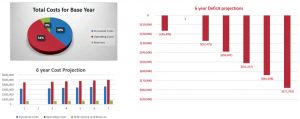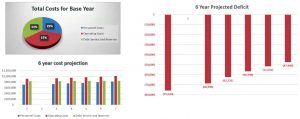Jean Holloway advises town officials to increase water, sewer rates in near future
By Ally Lanasa, Staff Writer
(Dec. 17, 2020) Berlin government needs to narrow the gap between the water it pumps and the water it bills, Jean Holloway, from Southeast Rural Community Assistance Project, Inc. (SERCAP) in Delaware and Eastern Maryland told the mayor and Town Council Monday.

Jean Holloway
Holloway’s advice came during her report on the evaluation and financial predictions of the water and sewer utilities.
SERCAP, which helps ensure that people in rural areas have clean and affordable drinking water, wastewater facilities and other services, has been assisting Berlin at no charge.
Holloway gave a presentation to the mayor and council in late August 2019. As a result of covid-19, a full rate analysis was paused.
Holloway’s presentation on Monday was not a rate study, but an assessment of financial projections and some recommendations for action because some issues require immediate action to sustain the town’s utilities.
“There’s always three things in any preliminary rate analysis that I recommend be done before you even think about the rates. One is to get a handle on collections, and at the time (in August 2019) Berlin had an excellent collection rate. It was above what I usually recommend, which is 25 percent,” Holloway said. “The second thing that I recommend is reducing or eliminating altogether any gallons that are included in the minimum bill.”
The third and significant recommendation is to get a handle on non-revenue water.
Holloway said non-revenue water is lost or unbilled water that still costs to produce.
Non-revenue water can be real losses (gallons) or apparent losses on paper.
“If you’re losing water, you’re losing sewer revenue as well as water revenue,” she said.
Holloway again recommended that the Town Council replace the town’s water meters because they are under-registering.
The American Water Works Association (AWWA) suggests no more than 10 percent of water should be non-revenue water.
Berlin’s annual loss from 11 months of figures is 25 percent of production.
“The highest month was a 41 percent gap between what was produced and what was billed,” Holloway said. “The lowest was 13 percent.”
That 25 percent annual loss is translated into 37 million gallons of water that is not paid for but is being produced. That equates to $157,482 lost in water revenue and $252,565 lost in sewer revenue in only 11 months.
“Now, that may not be translated into gallon for gallon, dollar for dollar that’s actually lost, because there’s a lot of ways you can narrow the gap between production and what you’re getting billed for,” she said. “But even if it’s only half that, you’re losing a lot of money by this lost water.”
Non-revenue water in Berlin is primarily caused by the age of meters that under-register.
“Also, as I understand it, the … register does not trip until it gets to the next 1,000 gallons,” Holloway said.
Paper loss may be caused by software and record inaccuracies by town administration.
Holloway added that conservatively 5 percent of water volume is likely in the lines, which creates a line loss.
Other sources of non-revenue water are leaks, hydrant flushing, storage tank refills, line breaks, repairs, filter backwash fire flows, authorized uses that are not charged such as for town buildings and fire houses and unauthorized uses such as stealing the service.
The water utility financial picture showed total costs for the 2020 base year with 54 percent of costs for operation, 38 percent of costs for personnel and 8 percent of costs for reserves.

CHART COURTESY SERCAP
Berlin’s water utility financial picture projects a deficit over the next six years because of non- revenue water, said Jean Holloway from Southeast Rural Community Assistance Project, Inc. (SERCAP).
“The water system has no debt as you know, but it’s projected to have a deficit over the next six years,” Holloway said.
She added that the water deficit can be significantly reduced or even eliminated by replacing meters.
“I also would suggest, before that’s even thought about, a water audit, which we can also help with, to determine the actual gallons lost versus apparent loss,” Holloway continued.
Meanwhile, the sewer utility has significant debt.
The sewer utility financial picture showed total costs for the 2020 base year with 37 percent of costs for operation, 29 percent of costs for personnel and 34 percent of costs for reserves and debt service.
“The sewer deficit looks like it’s going to lessen over the course of the five-year period. It’s at its highest right now,” Holloway said. “But the thing that struck me is that one-third of your costs go to debt service and reserves.”
That debt-to-revenue ratio is very unfavorable to any lender or funder, she added.

CHART COURTESY SERCAP
Although Berlin’s sewer utility currently has significant debt, the sewer utility financial picture projects a decrease in deficit over the next five years, said Jean Holloway from Southeast Rural Community Assistance Project, Inc. (SERCAP).
In the near term, Holloway said town officials should increase rates to make up for the projected deficit until a cost recovery rate can be adopted. She also recommended the town staff develop a plan and timetable to replace water meters and associated software. The sewer found debt load should be examined for possible retirement or refinancing options as well, she said.
Furthermore, a cost recovery rate analysis should be conducted for both water and sewer. The town staff should identify funding options and apply for funds to replace meters. Holloway said she will provide alternatives for restructuring the rates based on the rate study.
In the long-term, both utilities should work toward full cost recovery and sustainability, Holloway said.
SERCAP can assist the town staff with developing a water meter replacement plan by identifying sources of funding for water meter replacement, helping with applications for funding, conducting a full cost recovery rate analysis and re-structuring and conducting a water audit.
She also said it can help investigate opportunities for re-financing existing debt and setting up an asset management plan to make both systems more sustainable.
According to Jamey Latchum, the town’s stormwater and wastewater superintendent, 70 percent of water meters are 25-30 years old, while the lift of a meter is between 10 and 15 years.
Holloway also told the mayor and council that the town needs to establish a capital reserve and address the water loss.
Responding to Councilman Jack Orris, Natalie Saleh, Berlin’s finance director, said the first part of replacing the water meters is to apply for grants to fund the project.
